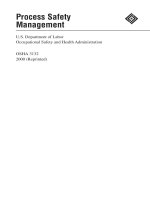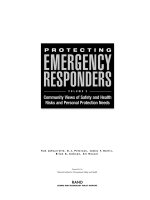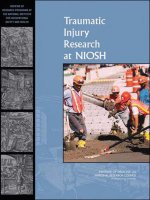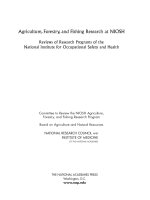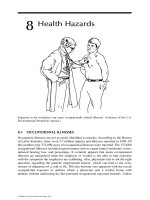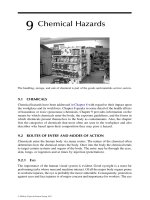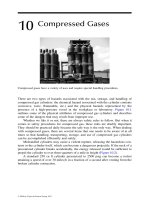Dessler HRM 12e ch 016 employee safety and health
Bạn đang xem bản rút gọn của tài liệu. Xem và tải ngay bản đầy đủ của tài liệu tại đây (1.57 MB, 56 trang )
Chapter 16
Employee Safety
and Health
Part Five | Employee Relations
Copyright © 2011 Pearson Education, Inc.
publishing as Prentice Hall
PowerPoint Presentation by Charlie Cook
The University of West Alabama
WHERE WE ARE NOW…
Copyright © 2011 Pearson Education, Inc. publishing as Prentice Hall
16–2
LEARNING OUTCOMES
1. Explain the supervisor’s role in safety.
2. Explain the basic facts about safety law and OSHA.
3. Answer the question, “What causes accidents?”
4. List and explain five ways to prevent accidents.
5. Minimize unsafe acts by employees.
6. List five workplace health hazards and how to deal
with them.
7. Discuss the prerequisites for a security plan and
how to set up a basic security program.
Copyright © 2011 Pearson Education, Inc. publishing as Prentice Hall
16–3
The Supervisor’s Role in Safety
• Safety is not just a case of legal
compliance or humanitarianism.
• Safety is the employer’s responsibility.
• Safety starts with top management commitment.
• Safety is an essential part of the on-site
supervisor’s job.
Copyright © 2011 Pearson Education, Inc. publishing as Prentice Hall
16–4
Occupational Safety Law
• Occupational Safety and Health Act
The law passed by Congress in 1970 to assure so far as
possible safe and healthful working conditions and to preserve
human resources.
• Occupational Safety and Health Administration (OSHA)
The agency created within the Department of Labor to set safety
and health standards for almost all workers in the United States.
Copyright © 2011 Pearson Education, Inc. publishing as Prentice Hall
16–5
OSHA Standards and Record Keeping
• OSHA Standards
OSHA sets general industry standards, maritime standards,
construction standards, other regulations and procedures,
and issues a field operations manual.
• Record Keeping
Employers with 11 or more employees must maintain records
of, and report, occupational injuries and occupational
illnesses.
Occupational illness
Any abnormal condition or disorder caused by exposure
to environmental factors associated with employment.
Copyright © 2011 Pearson Education, Inc. publishing as Prentice Hall
16–6
FIGURE 16–1
OSHA Standards Example
Guardrails not less than 2” × 4” or the equivalent and not less than
36” or more than 42” high, with a midrail, when required, of a 1” ×
4” lumber or equivalent, and toeboards, shall be installed at all
open sides on all scaffolds more than 10 feet above the ground or
floor. Toeboards shall be a minimum of 4” in height. Wire mesh
shall be installed in accordance with paragraph [a] (17) of this
section.
Copyright © 2011 Pearson Education, Inc. publishing as Prentice Hall
16–7
FIGURE 16–2
What Accidents Must Be Reported Under
the Occupational Safety and Health Act?
Copyright © 2011 Pearson Education, Inc. publishing as Prentice Hall
16–8
FIGURE 16–3 Form Used to Record Occupational Injuries and Illnesses
Copyright © 2011 Pearson Education, Inc. publishing as Prentice Hall
16–9
OSHA Inspection Priorities
• Inspections of imminent danger situations
• Inspections of catastrophes, fatalities, and
accidents that have already occurred
• Inspections related to valid employee complaints
of alleged violation standards
• Periodic, special-emphasis inspections aimed at
high-hazard industries, occupations, or substances
• Random inspections and reinspections
Copyright © 2011 Pearson Education, Inc. publishing as Prentice Hall
16–10
Citations and Penalties
• Citation
Is a summons informing employers and employees
of the regulations and standards that have been
violated in the workplace.
• Penalties
Are calculated based on the gravity of the violation
and usually take into consideration factors like the
size of the business, the firm’s compliance history,
and the employer’s good faith.
Copyright © 2011 Pearson Education, Inc. publishing as Prentice Hall
16–11
FIGURE 16–4 Most Frequently Cited Hazards
Copyright © 2011 Pearson Education, Inc. publishing as Prentice Hall
16–12
Inspection Guidelines
• Initial Contact
Refer inspector to the company’s OSHA coordinator.
Check inspector’s credentials.
Ask inspector why he or she is inspecting the workplace:
Complaint? Regular scheduled visit? Fatality or accident
follow-up? Imminent danger?
If the inspection stems from a complaint, you are entitled
to know whether the person is a current employee, though
not the person’s name.
Notify your counsel.
Copyright © 2011 Pearson Education, Inc. publishing as Prentice Hall
16–13
Inspection Guidelines (cont’d)
• Opening Conference
Establish focus and scope of the planned inspection.
Discuss procedures for protecting trade secret areas.
Show inspector that you have safety programs in place.
He or she may not go to the work floor if paperwork
is complete and up to date.
Copyright © 2011 Pearson Education, Inc. publishing as Prentice Hall
16–14
Inspection Guidelines (cont’d)
• Walk-Around Inspection
Accompany the inspector and take detailed notes.
If inspector takes a photo or video, you should, too.
Ask for duplicates of all physical samples and copies
of all test results.
Be helpful and cooperative, but don’t volunteer information.
To the extent possible, immediately correct any violation
the inspector identifies.
Copyright © 2011 Pearson Education, Inc. publishing as Prentice Hall
16–15
Responsibilities and Rights of Employers
• Employer Responsibilities
To meet the duty to provide “a workplace free from
recognized hazards.”
To be familiar with mandatory OSHA standards.
To examine workplace conditions to make sure
they conform to applicable standards.
• Employer Rights
To seek advice and off-site consultation from OSHA.
To request and receive proper identification of the OSHA
compliance officer before inspection.
To be advised by the compliance officer of the reason
for an inspection.
Copyright © 2011 Pearson Education, Inc. publishing as Prentice Hall
16–16
Responsibilities and Rights of Employees
• Employee Responsibilities
To comply with all applicable OSHA standards.
To follow all employer safety and health rules and regulations.
To report hazardous conditions to the supervisor.
• Employee Rights
The right to demand safety and health on the job
without fear of punishment.
• OSHA cannot cite employees for violations of their
responsibilities.
Copyright © 2011 Pearson Education, Inc. publishing as Prentice Hall
16–17
FIGURE 16–5
OSHA Safety Poster
Copyright © 2011 Pearson Education, Inc. publishing as Prentice Hall
16–18
Dealing with Employee Resistance
• The employer is liable for any penalties that result from
employees’ noncompliance with OSHA standards.
Ways to gain compliance
Bargain with the union for the right to discharge or discipline
an employee who disobeys an OSHA standard.
Establish a formal employer-employee arbitration process
for resolving OSHA-related disputes.
Use positive reinforcement and training for gaining
employee compliance.
Copyright © 2011 Pearson Education, Inc. publishing as Prentice Hall
16–19
10 Ways To Get into Trouble with OSHA
1.
Ignore or retaliate against employees who raise safety issues.
2.
Antagonize or lie to OSHA during an inspection.
3.
Keep inaccurate OSHA logs and have disorganized safety files.
4.
Do not correct hazards OSHA has cited you for and ignore
commonly cited hazards.
5.
Fail to control the flow of information during and after an
inspection.
6.
Do not conduct a safety audit, or identify a serious hazard
and do nothing about it.
7.
Do not use appropriate engineering controls.
8.
Do not take a systemic approach toward safety.
9.
Do not enforce safety rules.
10. Ignore industrial hygiene issues.
Copyright © 2011 Pearson Education, Inc. publishing as Prentice Hall
16–20
What Causes Accidents?
Basic Causes
of Accidents
Chance
occurrences
Unsafe
conditions
Copyright © 2011 Pearson Education, Inc. publishing as Prentice Hall
Employees’
unsafe acts
16–21
Improperly guarded
equipment
Improper
ventilation
Defective
equipment
Unsafe
Conditions
Hazardous
procedures
Improper
illumination
Unsafe/Untidy
storage
Copyright © 2011 Pearson Education, Inc. publishing as Prentice Hall
16–22
FIGURE 16–6
Checklist of
Mechanical or
Physical AccidentCausing Conditions
Copyright © 2011 Pearson Education, Inc. publishing as Prentice Hall
16–23
FIGURE 16–7
Online Safety
Inspection Checklist
Copyright © 2011 Pearson Education, Inc. publishing as Prentice Hall
16–24
FIGURE 16–8
Cut-Resistant
Gloves Web Ad
Copyright © 2011 Pearson Education, Inc. publishing as Prentice Hall
16–25

